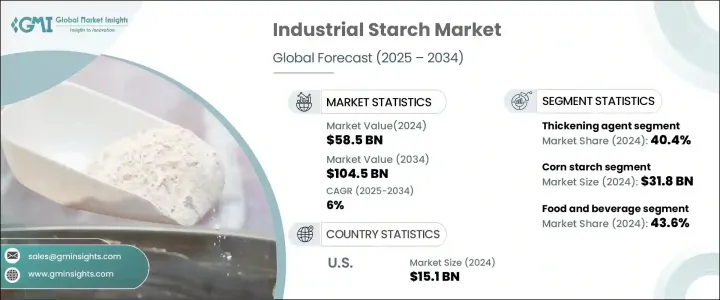
세계의 산업용 전분 시장은 2024년에 585억 달러로 평가되었으며, 2025년부터 2034년까지 연평균 복합 성장률(CAGR) 6%를 나타내 강력한 성장을 보일 것으로 예측됩니다.
이 급성장은 옥수수, 감자, 밀, 카사바, 쌀 등의 천연 자원에서 유래하는 산업용 전분의 다목적 용도에 의한 것이 큽니다. 증점, 결합, 안정화와 같은 독특한 특성을 가진 산업용 전분은 다양한 분야에서 필수적입니다. 식품 및 음료에서의 사용은 매우 중요하며 많은 제품에서 식감, 안정성 및 결합력을 높입니다.

그러나 그 유용성은 식품 산업에만 국한되지 않으며 전분은 제지, 섬유, 접착제, 바이오플라스틱과 같은 비 식품 용도에서도 필수적인 성분입니다. 친환경 포장과 바이오플라스틱과 같은 지속 가능한 제품으로의 변화가 증가함에 따라 전분 기반 솔루션에 대한 수요가 더욱 높아지고 있습니다. 건강 지향적이고 환경적으로 지속 가능한 선택을 추구하는 소비자의 선호와 일치하여 합성 첨가물을 대체하는 보다 깨끗한 천연 성분을 추구하는 기업이 늘어나 시장이 확대되고 있습니다.
| 시장 범위 | |
|---|---|
| 시작 연도 | 2024년 |
| 예측 연도 | 2025-2034년 |
| 시작 금액 | 585억 달러 |
| 예측 금액 | 1,045억 달러 |
| CAGR | 6% |
식음료 분야는 산업용 전분의 가장 큰 소비자이기도 하지만, 이는 다양한 제형의 질감과 안정성을 향상시키는 중요한 역할을 하기 때문입니다. 또한 비식품 산업에서는 제품의 성능, 효율성 및 지속가능성을 높이기 위해 전분에 대한 의존도가 높아지고 있습니다. 다양한 분야의 기업들이 전분의 다양한 기능성을 인식하고 생산 공정을 최적화하는 방법을 모색하고 있기 때문에 전분 시장은 계속 성장하고 있습니다. 예를 들어 식품 가공에서 전분은 수프, 소스, 구운 과자의 주요 증점제 및 안정제 역할을하며 인공 첨가물을 대체하는 비용 효율성과 품질이 높은 대안을 제공합니다.
산업용 전분은 주로 옥수수, 감자, 밀, 카사바, 쌀에서 유래합니다. 그 중에서도 옥수수 전분이 시장을 선도하고 있으며, 2024년에는 318억 달러를 창출했습니다. 이 이점은 옥수수의 비용 효율성, 높은 가용성 및 광범위한 용도로 제공됩니다. 옥수수 전분 분야는 특히 식품 가공에 대한 높은 수요가 계속되고 있으며, 다양한 식품의 증점과 안정화에 중요한 역할을 하고 있습니다.
기능별로, 증점제 부문은 2024년에 40.4%라는 큰 시장 점유율을 차지했습니다. 편의점 후드에 대한 소비자 수요 증가와 더 깨끗한 천연 소재로의 전환이 이러한 추세를 뒷받침하고 있습니다. 전분 기반 증점제는 천연 유래와 건강 지향의 매력으로 합성 첨가물의 대체품으로 선호됩니다.
미국의 산업용 전분 시장은 2024년 151억 달러로 평가되었습니다. 농업의 진보, 식품 가공에 있어서 수요 증가, 비식품 용도에서의 전분 사용의 확대 등의 요인이 성장을 뒷받침하고 있습니다. 투명성과 천연 성분에 대한 소비자의 선호에 힘입어 클린 라벨 제품의 상승은 가공 식품에서 전분 채용을 추진하는 주요 요인입니다. 또한 제지 및 포장과 같은 업계는 제품의 강도, 재활용성 및 지속가능성을 높이기 위해 전분을 활용하여 이러한 분야 수요 증가를 지원합니다. 전분 기반 바이오플라스틱과 같은 환경 친화적인 대체품을 추구하는 움직임은 지속 가능한 소재에 대한 규제 당국의 지원이 증가함에 따라 새로운 성장 길을 열고 있습니다.
The Global Industrial Starch Market, valued at USD 58.5 billion in 2024, is projected to witness robust growth, expanding at a CAGR of 6% from 2025 to 2034. This surge is largely driven by the versatile applications of industrial starch derived from natural sources like corn, potato, wheat, cassava, and rice. With its unique properties, including thickening, binding, and stabilizing, industrial starch is indispensable across various sectors. Its use in food and beverages is pivotal, where it enhances texture, stability, and binding in numerous products.

However, its utility isn't limited to the food industry; starch is also an essential component in non-food applications such as paper manufacturing, textiles, adhesives, and bioplastics. The growing shift towards sustainable products, such as eco-friendly packaging and bioplastics, is further propelling the demand for starch-based solutions. The market is expanding as businesses seek cleaner, more natural ingredients to replace synthetic additives, aligning with consumer preferences for health-conscious and environmentally sustainable options.
| Market Scope | |
|---|---|
| Start Year | 2024 |
| Forecast Year | 2025-2034 |
| Start Value | $58.5 Billion |
| Forecast Value | $104.5 Billion |
| CAGR | 6% |
The food and beverage sector remains the largest consumer of industrial starch, owing to its critical role in improving the texture and stability of various formulations. In addition, non-food industries are increasingly relying on starch to enhance product performance, efficiency, and sustainability. The starch market continues to grow as companies from different sectors recognize its diverse functionalities and seek ways to optimize their production processes. For example, in food processing, starch acts as a primary thickener and stabilizer in soups, sauces, and baked goods, offering cost-effective and high-quality alternatives to artificial additives.
Industrial starch is mainly derived from corn, potato, wheat, cassava, and rice. Among these, corn starch leads the market, generating USD 31.8 billion in 2024. This dominance is driven by corn's cost-effectiveness, high availability, and wide-ranging applications. The corn starch segment continues to see high demand, particularly in food processing, where it plays a key role in thickening and stabilizing various food products.
By function, the thickening agent segment held a substantial market share of 40.4% in 2024. The growing consumer demand for convenience foods, coupled with the shift towards cleaner, natural ingredients, is driving this trend. Starch-based thickeners are becoming a preferred alternative to synthetic additives due to their natural origins and health-conscious appeal.
In the U.S., the industrial starch market was valued at USD 15.1 billion in 2024. Factors such as advancements in agriculture, increased demand in food processing, and the expanding use of starch in non-food applications are fueling growth. The rise of clean-label products, driven by consumer preferences for transparency and natural ingredients, is a major factor propelling starch adoption in processed foods. Furthermore, industries like paper and packaging are leveraging starch to enhance product strength, recyclability, and sustainability, supporting the growing demand in these sectors. The push for eco-friendly alternatives, such as starch-based bioplastics, opens new growth avenues, with increasing regulatory support for sustainable materials.